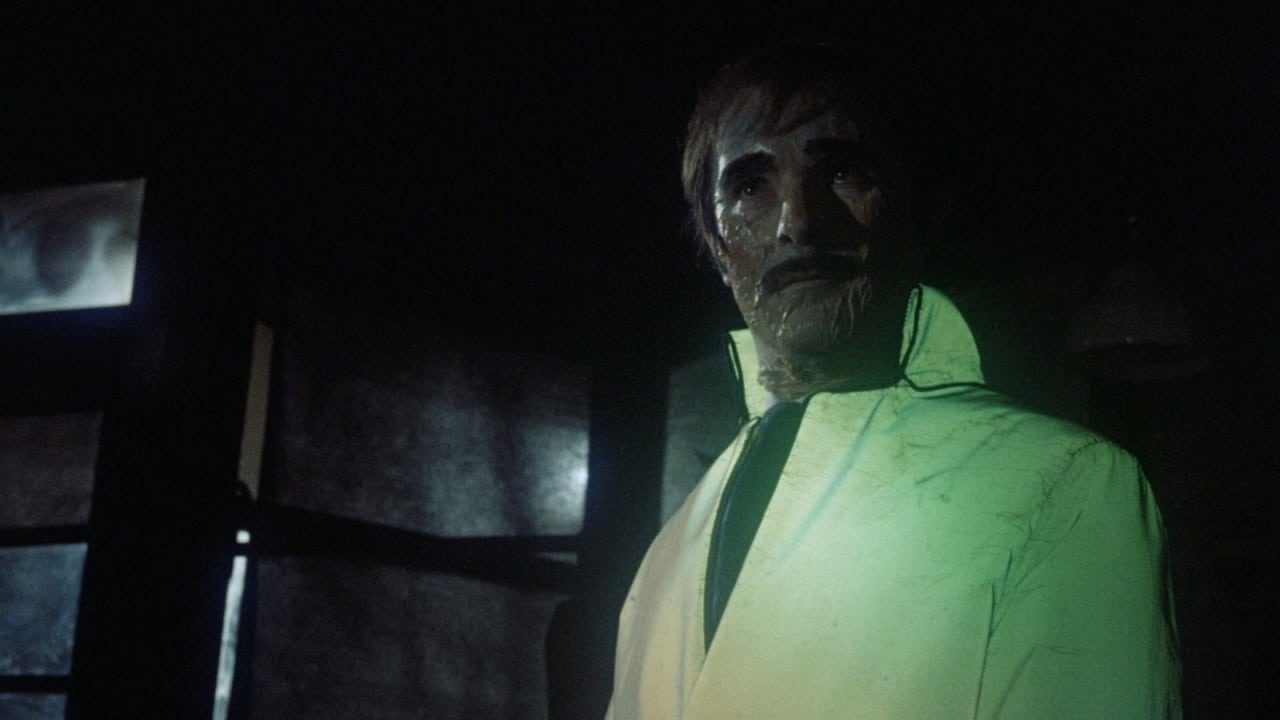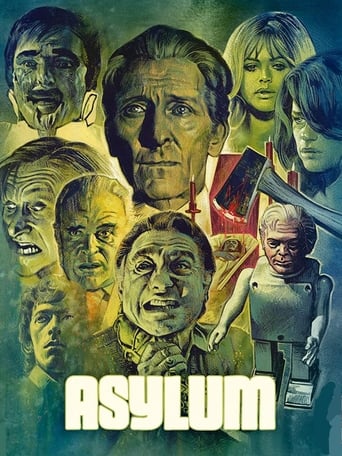

Psychiatrist is called to an asylum for a job interview, finds the institute's staff as strange as the patients. Long-winded, slowly-mounted cycle of scary stories from horror-house Amicus Productions and the pen of original "Psycho" author Robert Bloch. Tales include an adulterous man and woman who become the target of revenge from his wife's dismembered corpse; a tailor who receives oddly specific instructions on the construction of a haunted suit; a disturbed girl (Charlotte Rampling, with freckles), either the victim of delusion or illusion, who is charged with a double-homicide that she says was committed by a woman who doesn't exist; and a patient who has made a robot doll in his own image and believes he can will it to life. Shuddery episodes of murder and insanity produce a few shivers, but no standout moments or performances. *1/2 from ****
... View More'Asylum' is an anthology film from the Amicus Company, based on stories by Robert Bloch. It has the distinction of proving more popular than the Hammer films of the time. The bombastic strains of 'Night on Bald Mountain' by composer Modest Mussorgsky accompany Dr Martin (Robert Powell) as he drives towards an imposing, mist-drenched asylum where he is to attend a job interview with Doctor Rutherford (Patrick Magee). This 1867 score is used again as Martin explores the corridors of the stately building – to be honest, the music is certainly rousing, but is too much to accompany what is after all, a man looking at some pictures, no matter how unsightly the images of early psychiatric treatments may be.Rutherford sets Martin a task. If he can identify former medical specialist Dr Starr amongst the inmates, the position is his. He has to visit a selection of cases – first, guided by the orderly Reynolds (Geoffrey Bayldon, in a role for which Spike Milligan was also considered), he meets Bonnie (Barbara Parkins). What follows in 'Frozen Fear', is that Walter (Richard Todd) and Bonnie agreed to dismember Walter's wife, occult practitioner Ruth (Sylvia Syms) and live off her money. Despite this, she escapes from the freezer into which her various body parts have been stored, and her assorted limbs, head (which is still breathing) and torso, carefully wrapped in brown paper and string, attack first Walter and then Bonnie apparently (we see this in flashback, and it is one of this film's greatest and most effective scenes. It is intentionally horrific and hilarious, perfectly balanced). This is Bonnie's story, but she has no proof, only gaping wounds on her face where she axed her alleged attacker/s. Chances are, if you have seen this film, then the scene of the dismembered limbs scuttling across the floor is what will stick in your mind.'The Weird Tailor' is next. Barry Morse plays Bruno, a struggling tailor who accepts an order from 'Mr Smith' (Peter Cushing) to create a suit made from special material, and to work on this at specific times over four nights. Smith promises a great deal of cash, but when the suit is delivered, is revealed to live in a house empty of furniture: Smith is penniless. Both actors are at a peak here and ably supported by Ann Firbank as Bruno's wife (Bruno is a lot more sympathetic here than in Bloch's original story and our sympathies are with him throughout as a result). Even the (enjoyable) silliness at the end of the episode doesn't detract from its deep sense of melancholy and longing. Directed often in close-up, the squalidity of the two men's desperation is expertly conveyed. This is not only my favourite segment from 'Asylum', but from any Amicus production.Any tale that follows that would be hard pressed to match it, and sadly 'Lucy Comes to Stay' (originally planned as the first instalment, but moved to third place at Producer Milton Subotsky's insistence) is the weakest of the three. This is by no means a bad story, the climax nevertheless shares similarities with 'Frozen Fear'. It contains a terrific cast including James Villiers, Charlotte Rampling, Megs Jenkins and Britt Ekland.Another Doctor – Doctor Byron – features next. Played by the always brilliant Herbert Lom, Byron has created tiny mannequins based on former colleagues of his. 'These are not ordinary figures', he explains, and goes on to explain that each figure is living and perfectly capable of functioning. He can bring them to life with his 'conscious', and his final model is based on himself. Absurdly (the viewer has to go along with this for it to be effective), this last mannequin travels downstairs and kills Doctor Rutherford, who is responsible for Byron's incarceration.And yet who is the elusive Dr Starr? The answer is brilliantly directed by stalwart Roy Ward Baker. It is the Bayldon's orderly. Starr killed the original Reynolds, and does the same to Dr Martin. We finally see him as he truly is, frighteningly deranged, holding a stethoscope to Martin, cackling furiously, an insane child-like laughter. Bayldon is terrific throughout. Often a player of secondary characters, he is unassuming and courteous – and that is why the reveal is so very effective.Finally, another candidate for the job arrives at the asylum and is greeted by Bayldon, echoing an earlier line about closing the door and keeping out the draughts. 'As Dr Starr used to say' he remarks with a knowing glance to the audience. Witty and unnerving, this is my favourite Amicus film.
... View MoreViewed in 2013, this film is a strange mixture. A lot of its plot elements seem corny and it's let down badly by the mannikins in the final episode, which fall laughably below the description given by their creator in the dialogue. Douglas Gamley's music score seems a cop-out in some respects, stealing great chunks of Mussorgsky's Night on Bare Mountain and Pictures at an Exhibition without mention in the credits. However, in its quieter moments the music is wonderfully atmospheric, creating an eerie ambiance unmatched by any other composer in horror films of the period - managing to evoke the 1970s with clever use of a Vibraphone, mixing in other "period" instruments like an electric organ and yet somehow never sounding "cheesy".The script is excellent except for a few bits of clunky dialogue. "No-one can stop me now" would have sounded much better as "No-one will stop me from doing this." That the film still works is down largely to the excellent cast. The number of good (even great) actors that was affordable within the Amicus budget is amazing - Geoffrey Bayldon, Megs Jenkins, Patrick Magee, Robert Powell, Charlotte Rampling, Sylvia Syms, Richard Todd, James Villiers - a roll-call of British acting talent. Probably the best of all are Barry Morse and Peter Cushing, both giving performances that outshine many more respected actors, and depicting a vaguely absurd storyline with utter conviction. Barry Morse even manages to be convincing while affecting an eastern European accent - an achievement for any Anglophone actor - and the double act between these two greats turns their episode into a genuine tragedy.Asylum is never less than watchable and, in its best moments, is genuinely chilling.
... View MoreThere were some good story, in this anthology movieThe first was, Well i was little confused but I really liked how the story went, there were some odd moments in that segment.The second Story, I found it very dull and boring, I did like the end of the story but not a good as the first story.The Third story was not bad , I did enjoy that story but I found the whole thing very predicableThe end of the movie was very decent, Well that crazy doc, sure dose have one crazy laughing voiceThe acting was really good in this movie, from everyone in, every story ,some of them could have been better.I give this movie 6/10
... View More